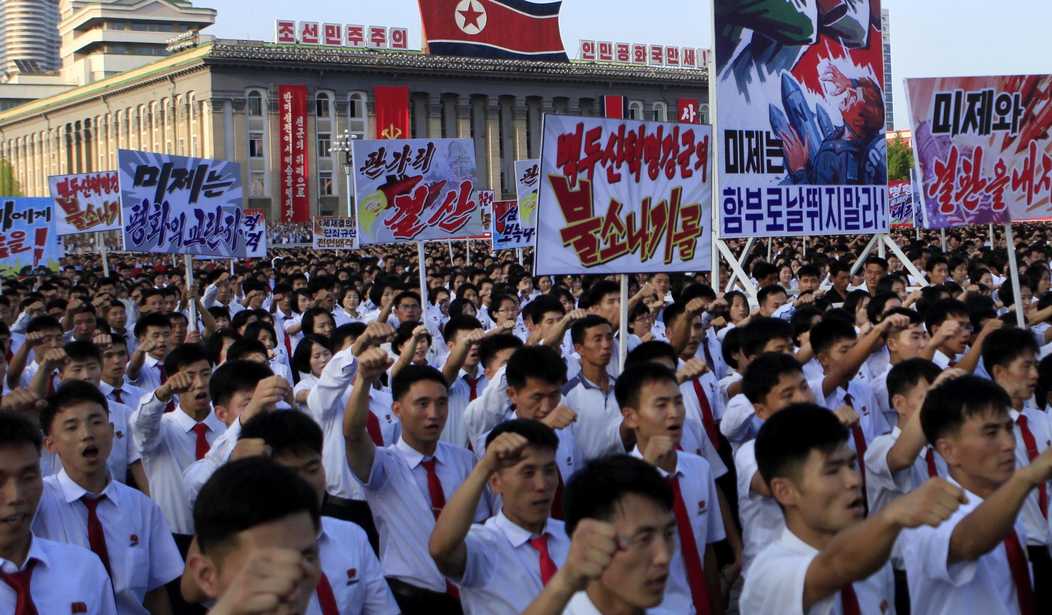WASHINGTON — Defense Secretary James Mattis sounded a sterner warning toward North Korea today than Secretary of State Rex Tillerson’s insistence that the nuclear crisis was nothing to lose sleep over, with the State Department declaring that the administration was nonetheless all on the same page about the threat posed by Kim Jong-un’s regime.
Then North Korea sounded off again after its Tuesday warning that the regime was formulating plans to strike Guam, saying today that the launch plan will be ready for Kim’s approval by mid-month and entail four Hwasong-12 rockets crossing “the sky above Shimane, Hiroshima and Koichi Prefectures of Japan,” said the North’s official Korean Central News Agency. “They will fly 3,356.7 km (2,085.8 miles) for 1,065 seconds and hit the waters 30 to 40 km away from Guam.”
Pyongyang said the intermediate-range missiles would “interdict the enemy forces on major military bases on Guam” and “signal a crucial warning to the U.S.”
“Sound dialogue is not possible with such a guy bereft of reason and only absolute force can work on him,” said the statement from Korean People’s Army Gen. Kim Rak-gyom, adding that President Trump’s “fire and fury” warning was a “load of nonsense” and was “extremely getting on the nerves” of North Korea’s military.
Mattis said in a statement released before the latest KCNA threat today that Kim “should take heed of the United Nations Security Council’s unified voice, and statements from governments the world over, who agree the DPRK poses a threat to global security and stability.”
“The DPRK must choose to stop isolating itself and stand down its pursuit of nuclear weapons. The DPRK should cease any consideration of actions that would lead to the end of its regime and the destruction of its people,” Mattis said.
“President Trump was informed of the growing threat last December and on taking office his first orders to me emphasized the readiness of our ballistic missile defense and nuclear deterrent forces. While our State Department is making every effort to resolve this global threat through diplomatic means, it must be noted that the combined allied militaries now possess the most precise, rehearsed and robust defensive and offensive capabilities on Earth,” he added. “The DPRK regime’s actions will continue to be grossly overmatched by ours and would lose any arms race or conflict it initiates.”
Trump said Tuesday about a report that Pyongyang had successfully miniaturized a warhead to fit on an intercontinental ballistic missile: “North Korea best not make any more threats to the United States. They will be met with fire and fury like the world has never seen. He has been very threatening beyond a normal statement. And as I said, they will be met with fire, fury, and, frankly, power, the likes of which this world has never seen before.”
Before Mattis’ remarks today Tillerson told reporters en route to Guam that what Trump is doing “is sending a strong message to North Korea in language that Kim Jong-un would understand, because he doesn’t seem to understand diplomatic language.” Tillerson said talks were the way forward in the crisis, and added that “Americans should sleep well at night, have no concerns about this particular rhetoric over the last few days.”
Asked if there is a longer-term threat to Guam, the secretary of State replied, “Well, I hope not.”
At the State Department today, press secretary Heather Nauert said “the White House, the State Department, the Department of Defense, we are speaking with one voice.”
“The secretary and the president have ongoing conversations. They spoke earlier today. This pressure campaign with North Korea is something that we are all in agreement on — folks in the U.S. government are all in agreement on. So nothing — nothing has changed in that regard,” Nauert said.
After multiple questions on U.S. statements and strategy, Nauert declared “it was a good week for diplomacy — I know you all want to obsess over statements and all of that, and try to — want to make a lot of noise out of that.”
“But what is important to keep in mind is that this diplomatic pressure at ASEAN — at the meeting of the 10 Asian nations, along with the United States, came to a joint agreement and a joint statement, and put out a very strong condemnation of North Korea. We are all singing from the same hymn book,” she said.
Sen. Cory Gardner (R-Colo.), the author of North Korea sanctions legislation signed into law in February 2016, said he’s still calling on this administration to fully implement the punitive measures attached to individuals who contribute to DPRK’s nuclear program or human rights abuses “in order to dramatically ramp up pressure that can bring Kim Jong-un to his senses and to stop what would be a dramatic loss of life on the Korean Peninsula and a direct threat to U.S. military personnel stationed in the region.”
“We can only negotiate with this rogue regime from a position of strength, and I firmly believe the best option to stop North Korea goes through Beijing,” Gardner added. “China is responsible for 90 percent of North Korea’s trade, a tenfold increase in the last 15 years. It’s time to hold China accountable for their refusal to shut off trade with North Korea, and if they do not take the necessary steps to help us prevent a nuclear war, it must mean that business as usual is over between the United States and China.”









Join the conversation as a VIP Member